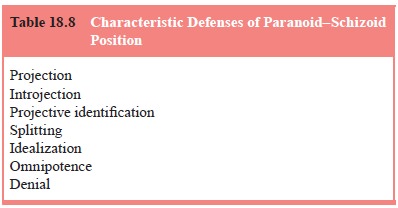Chapter: Essentials of Psychiatry: Psychoanalytic Theories
Psychoanalytic Theories: Melanie Klein
Melanie Klein
Klein’s (Klein, 1937, 1946) theoretical
formulations grew out of her observations of the psychotic children she
treated. Although some of her controversial ideas have never gained acceptance
in mainstream American psychoanalytic thought, her formulations about the
importance of aggression and envy, particularly in more primitively organized
patients, as well as her understanding of primitive defensive operations have
been central in the think-ing of later object relations theorists.
Klein believed that fantasy exists from the
beginning of life and is by definition the mental expression of the instincts.
She conceptualized the neonate as having an active inner world of fantasy based
on its innate libidinal and aggressive drives and their aims. The death
instinct is central to Klein’s theories. It finds its expression in earliest
infancy in aggression against the object and the self.
Klein modified Freud’s theories of psychological
develop-ment drastically. As mentioned, she focused predominantly on infancy,
describing two psychological “positions” during the first year of life (which
was for Freud the oral stage of development). These are the paranoid–schizoid
position (Table 18.8) during the first 6 months of life and the depressive
position during the sec-ond 6 months. The paranoid–schizoid position is
characterized by the defenses of projection, introjection, projective
identification, splitting, idealization, omnipotence and denial (Klein, 1946).

These defenses are termed primitive defenses
because they have their origin in early development, in contrast to the higher-level
defenses that evolve later. Projection
is the defensive externalization of a threatening internal impulse, ideal, or
feel-ing. Because this is the predominant defense of earliest infancy, the
young infant believes that the dangerous impulse, idea, or feeling, which
actually originated from within as a manifesta-tion of its own intense drives,
is coming from an external source. Therefore, the feared threat is perceived as
external rather than internal. This results in anxiety about being attacked from
with-out, termed paranoid anxiety.
Introjection takes place when an external object is taken inside (in fantasy) and becomes part of the internal rather than the external world. The paranoid position is characterized by projection and introjection taking place in cycles.
Projective
identification, as conceptualized by Klein, is a complicated primitive defense that involves the projection of
an internal object (usually a bad one) into an external object, followed by
identification with the external object that is now ex-perienced by the infant
as having been contaminated by the bad object.
Splitting
is the
intrapsychic separation of the object into
different partial objects. Typically, an unrealistically all-good
(idealized) object and an equally unrealistically all-bad object are
constructed. In the course of normal development, in the presence of adequate
parenting that provides the consistent availability of predominantly benign
external objects, the cycle of projection and introjection gradually results in
the introjection of more be-nign aspects of the external object (parent or
other caretaker), and the bad internal object is gradually detoxified.
Related Topics